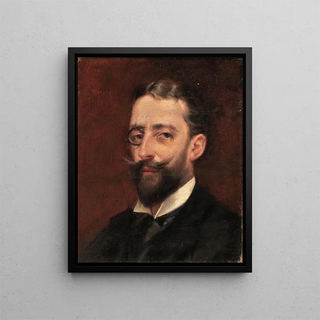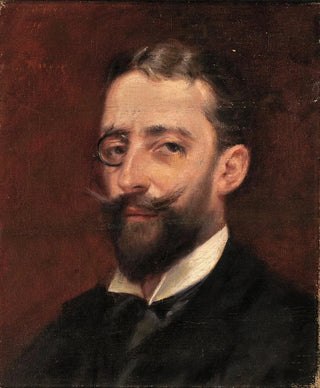Painting Man with Monocle - Alice Pike Barney | Art print


View from behind

Frame (optional)
Alice Pike Barney's "Man with a Monocle" is a captivating art print that evokes an era when portraiture was not only a means of immortalizing an individual but also a reflection of social aspirations and values. This piece, created at the end of the 19th century, embodies the nuances of bourgeois life through the penetrating gaze of a man with a monocle, a symbol of refinement and distinction. The delicate composition and use of colors create an intimate atmosphere, inviting viewers to ponder the identity of this enigmatic character. In this work, Barney manages to capture the very essence of her time while leaving a personal imprint that still resonates today.
Style and uniqueness of the art print
Alice Pike Barney's style is distinguished by her bold approach and refined chromatic choices. In "Man with a Monocle," rich hues and subtle contrasts are harmoniously arranged to bring to life a portrait that transcends simple representation. The artist skillfully plays with light and shadow, creating depth that draws the eye and stimulates the imagination. Details, such as the monocle itself, are treated with meticulous care, demonstrating Barney's technical mastery. This subject choice, a man whose gaze is both piercing and distant, opens a dialogue between the artist and the viewer, inviting each to explore the hidden stories behind this image. The art print also stands out for its psychological atmosphere, where every element is carefully considered to enhance the emotional impact of the portrait.
The artist and her influence
Alice Pike Barney, painter and also an influential figure of her time, successfully established herself in an artistic environment dominated by men. Born in 1857, she had the opportunity to mingle with many artists and intellectuals of her era, which nourished her creativity and artistic approach. Her work, often focused on portraiture, reflects not only the aesthetic concerns of the late 19th century but also the struggles and aspirations of women in the art world. Barney was a pioneer in female representation and contributed to

Matte finish

View from behind

Frame (optional)
Alice Pike Barney's "Man with a Monocle" is a captivating art print that evokes an era when portraiture was not only a means of immortalizing an individual but also a reflection of social aspirations and values. This piece, created at the end of the 19th century, embodies the nuances of bourgeois life through the penetrating gaze of a man with a monocle, a symbol of refinement and distinction. The delicate composition and use of colors create an intimate atmosphere, inviting viewers to ponder the identity of this enigmatic character. In this work, Barney manages to capture the very essence of her time while leaving a personal imprint that still resonates today.
Style and uniqueness of the art print
Alice Pike Barney's style is distinguished by her bold approach and refined chromatic choices. In "Man with a Monocle," rich hues and subtle contrasts are harmoniously arranged to bring to life a portrait that transcends simple representation. The artist skillfully plays with light and shadow, creating depth that draws the eye and stimulates the imagination. Details, such as the monocle itself, are treated with meticulous care, demonstrating Barney's technical mastery. This subject choice, a man whose gaze is both piercing and distant, opens a dialogue between the artist and the viewer, inviting each to explore the hidden stories behind this image. The art print also stands out for its psychological atmosphere, where every element is carefully considered to enhance the emotional impact of the portrait.
The artist and her influence
Alice Pike Barney, painter and also an influential figure of her time, successfully established herself in an artistic environment dominated by men. Born in 1857, she had the opportunity to mingle with many artists and intellectuals of her era, which nourished her creativity and artistic approach. Her work, often focused on portraiture, reflects not only the aesthetic concerns of the late 19th century but also the struggles and aspirations of women in the art world. Barney was a pioneer in female representation and contributed to
12,34 €






